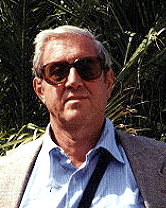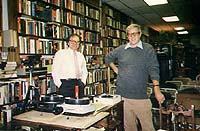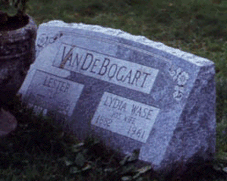


"As long as we are not assured of immortality, we shall never be fullfilled, we shall go on hating each other in spite of our need for mutual love."
Contents
 Click on image for larger view.
Click on image for larger view.
Willard Van De Bogart and Dr. Rolf Von Eckartsberg, Nov. 1987, Carson Street, South Side, Pittsburgh, PA
Lecture Presentation: "Venus Rising", co-presented with Dr. Elsa Von Eckartsberg
Existentialism, Co-Existentialism, and Immortality
How can we overcome the death barrier? Existentialism claims that we cannot. Our life is characterized by finitude which has death as its limit condition.. But the sting of death - mortality - and our acknowledgement of this reality makes us wake up to life and be resolute for our projects of self-realization. Yet we die alone!
But what if this existential conviction is based on shaky ground? Are we not born into family-community and do we not die within a community of extended family and friends within the social body of our "existential ensemble" (von Eckartsberg, 1979) which we have co-created by our living? This cast of chracters of our existence survives our death. The survival community is launched at the funeral of the deceased. While the dead person is lowered into the ground, the person's spirit is raised in the speech and imagination of the survivors. A spiritual rebirth occurs. To the deceased person a new state of being, a new life: social immortality is bestowed in and through our collective commemoration. It existes as a circulation in image-consciousness and speech. This is the point of view of co-existentialism. Personal immortality for oneself may well be impossible, but social immortality, continued life in the consciousness and speaking of others is not.
Existentialism focuses on subjectivity, the actor's point of view, and the life-span of the individual. The individual experiences the world and him-or-herself in consciousness which produces the meaning which guide our decisions and actions. In this article we will revision this ego-and conscio-centric attitude of existentialism with regards to the issues of immortality. Consciousness is not the autonomous creation of the person alone. It is grounded in and permeated by human language which co-articulates our experience. The life of community, of others, life in interpersonal relationships, life between us, precedes, envelopes, and succeeds the life of the individual.
Co-existentialism, in my view, was founded by Buber and Rosenstock-Huessy (von Eckartsberg, 1985). The starting point of co-existentialism is the conviction that we exist in relationships, and that we communicate with others and with ourselves through interaction and language. The between of co-existence is our primary reality and language is equiprimordial with consciousness. We talk to ourselves, we process reality in a private mode shaped by language. This private experience has to be articulated to others to achieve interpersonal and thus irrevocable social and moral reality. Once communicated, the person's experience in principle can live on in the memory and discourse of the listeners and, as such, it can survive the death of the speaker or writer. Co-existentialism discusses the multi-generational nature of human discourse and it emphasizes the study of interpersonal relationships-- our life in social network--which can survive the death of its members. Relationships may attain immortality in and through co-existence.
Return to:| Top |
Language can accomplish immortality. It does so in a relative manner depending on the extent and duration of the circulation discourse in co-existential networks. In the view of co-existentialism immortality is a social reality of discourse, as was especially true in ages steeped in the oral tradition. Co-existentialism aligns itself with this wisdom, hoping to bring it back to strengthen it in our fast-paced and forgetful modern era.
 Click on photo for history of Van De Bogart's
Click on photo for history of Van De Bogart's
Immortality is understood as life after death, better, life after life. Humankind has striven for immortality from time immemorial. The earliest human traces of communal burial ritual are found in graves 60-70,000 years ago. Graves are the living addresses of the dead.
The names of the dead are their addresses in our living language through which we can visit their presence and commerorate when alone or in discourse with one another. And the ritual observance of anniversaries bespeaks the continuing spiritual life-presence of the deceaced in the surviving community. As was said of Lincoln: "And now he belongs to the ages".
Rosenstock-Huessy (1970) says that in biological reality: "life precedes death," but that in the realm of the spirit, in human reality: "death precedes life;" the founder's death precedes the life of the institution or school of thought which he or she founded. The United States of America exists on the inspiration of the "founding fathers." Their constitution is our heritage, their founding acts are alive and sustain us today. Remembering means being able to survive the death of what is remembered.
Even in the spiritual life of the individual in the course of a lifetime the principle that "death preceeds life" holds in that we have to die to parts and stages of ourselves in order to free us to grow in new directions and to develop new spiritual life-forms. We have to die to but remember childhood and youth in order to be born into adulthood; we have to die to bachelorhood to become husbands and fathers; we have to die to the activities devoted to a project such as writing a book when it is completed so as to find new life in another project. In all major milestones and turning points in our life, we have to learn to die to our "old self" in order to be reborn into a "new self," we die old existential relationships and communicate and are reborn into new ones.
In this view death and immortality is very much a part of our own living and it plays an important part in the continuing life of our multigenerational social existence. Our life is punctuated be decisive events and by ends and beginnings which mark our life in terms of eras: B.E. before the event, and A.E. after the event. Through existential periodization which delineates the important chapters in our life, as individuals, as families, and as communities, we obtain our basic orientation in time: B.C., before Christ, and A.D., "anno domini," in the year of the Lord.
Return to: |Top |
The Fixed Stars of Proper Names
The name stands for the person. Every name is the title of a story, of the person's life-story (Schapp, 1976). Prpoer names are the fixed stars in the firmament of language. They act as foci, as crystallization points and magnetic poles which draw and hold all the facets of a person's life and all the stories which carry the meanings of these existential facts. Without names we would vanish in the anonymity of mass society, lost and forgotten in the oblivion of impersonal numbers and statistics. Names stabilize reality for us. They establish perceivable identities in the flux of changing perspectives.
Proper names, of persons, of groups, of places, and of times, constitute the foundation of language (Rosenstock-Huessy, 1981). Names identify entities: reference points. Without names we would lose all orientation in society, space, and time. WE would be cast adrift in the ocean of the world-process. Names establish stable points of referrence around which we can accumulate narrative lnowledge and upon which we can pass judgements. The proper names of persons and groups are our trans-temporal addresses in language and society which make meaningful speech to and about persons possible.
A person's life does not have an unequivocal meaning: the person's life story. There are as many stories as there are people telling them, although there is also much consensus. We find a myriad of written biographies and there may be an autobiography in the paradigm case of famous people. The "self-story" -- what my life menas to me -- is at best a privileged insider version of the life. A person's intimates, wife, husband, parents, children, friends, collegues, enemies, crtitics are as close to the action -- partners and participants in the life -- and often can see clearer into the living truth and reality of the deceased person. There is no ultimately priviledged point of view here for us. All circulating stories stand in a dialectical relationship with each other, demanding continual revisioning.
However, there are some "facts" which belong to the deceased, indisputable existential life facts, deeds and dates about which there is a consensus, and artefacts: mementos and possessions. In our technical age we have created print and photography and electro-magnetic storage capacities: computer memories, laser discs, cassette recordings, videos, as well as the more traditional writings of letters, of diaries, which provide touchpoints and clues --traces -- to a person's living. Every individual, especially in the industrial world, accumulates and collects a myriad of "things" which become disseminated or discarded after our bodily death. These things carry the spiritual meaning-traces of the person. Most of them vanish into oblivion over time. Fame is the crucial variable here. We remember and collect more about persons who are deemed important in the life of humanity: our culture-heros. Commemoration is relative to the size and the affection of the mourning community, of the circle of people who knew the deceased personally or through media.
Return to: |Top |
The Process of Immortalization
Love used to be considered stronger than death. Nowadays love often does not even survive life. In our era of disposable marriage and family relationships we are lucky to be remembered at all.
Fame once outlived the life of its hero. But, as Andy Warhol has remarked: "In the future, everybody will be world-famous for 15 minutes." Are we not entitled to more. to at least one day or at least one hour of commemoration each year which our folk wisdom and life praxix has institutionalized through anniversaries? But even anniversaries and their celebration diminish in frequency over time. The accellerating pace of our modern era and its increase in information bombardment seems paradoxically to have undermined our capacity for remberance and commeroration. Too many new events overlay and displace memory. We are in danger of becoming individuals and communities without a past.
The maintenance of the past as a living memory is of essential importance in the life of a group and of individuals. Knowing about origins, about past achievements and mistakes allows us to understand ourselves as links in the chain of generations, as partners in long-range, multi-generational co-existence. Commeroration also reminds us of our indebtedness to our ancestors upon whose achievements and shoulders we still stand. Through such remembrance we overcome our narcissism and we are reminded of the immortality of our spiritual social life.
The "process of immortalization" can best be studied in the reality of history and biographies. Historians shape and dominate our collective memories. Although the important names of personages, of places, and of events are first pronounced and propagated by the participant people, historians, after an initial surge of commentary, have been given the task of providing systemactic accounts of the important people and their important events: to narrate the past and its actors. All narritaive activity is devoted to the service of spiritual immortality.
The "great man" or "great person" theory of history has created the secular pantheon of the immortals, the luminaries of a culture, and accumulated and monumentalized the impressive documentations of these culture heroes. This approach has been based on an elitist bias: only the extraordinary personages and the leaders in their field have been accorded recognition and the honor of commemoration. All the others have been more or less forgotten leaving only faint traces in the barren date-banks of genealogy.
Continued on next page - Part II